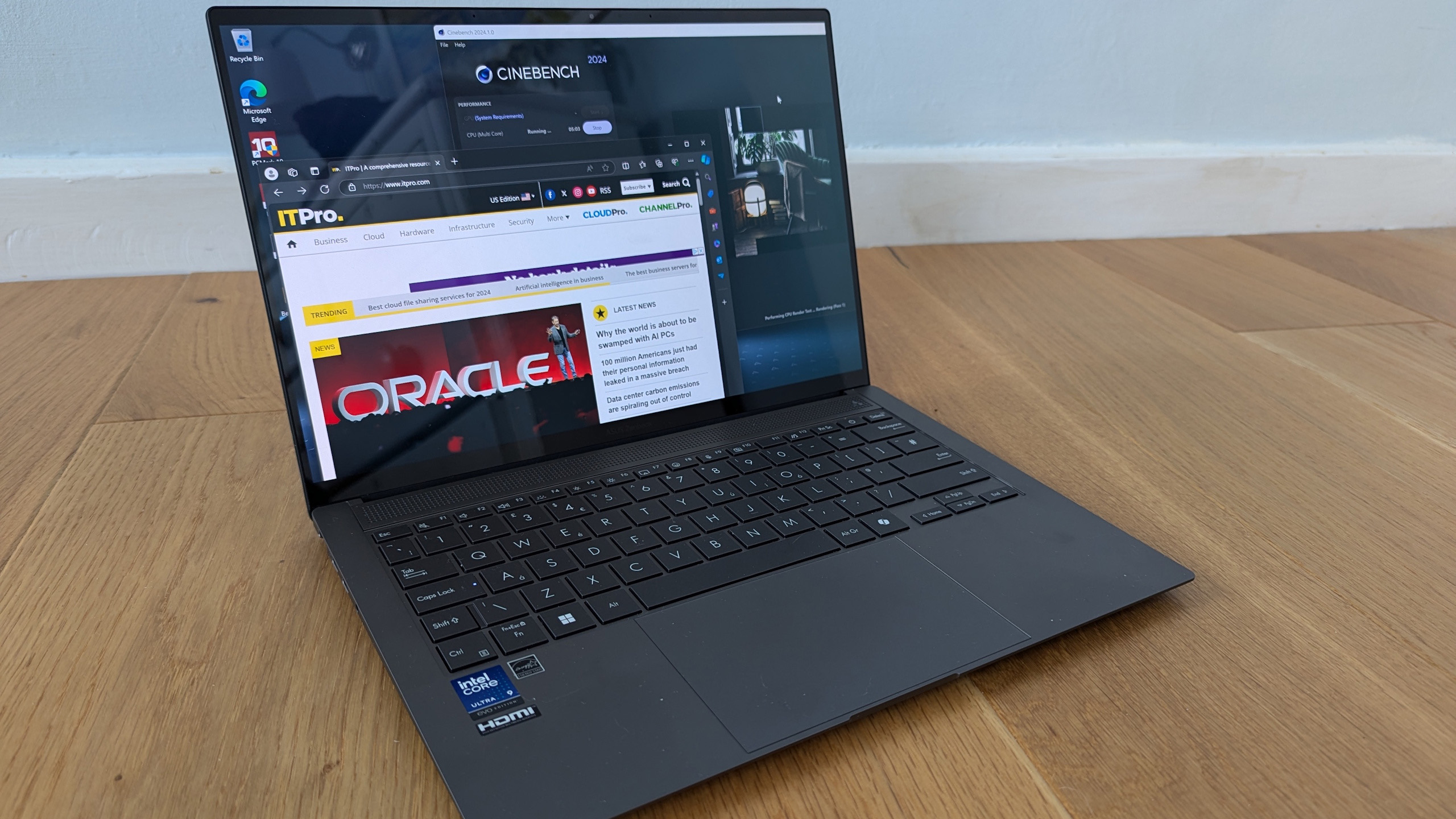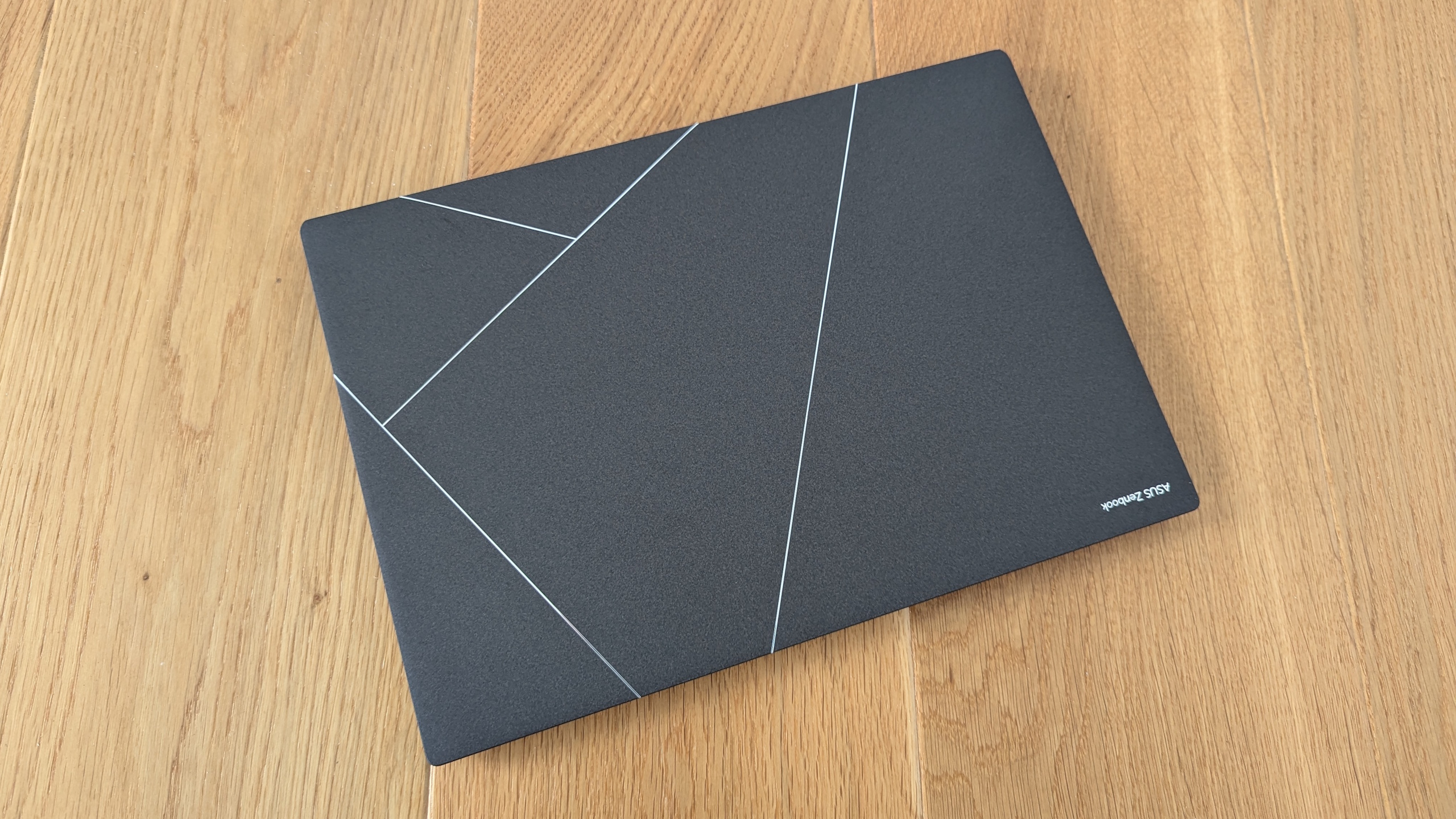Asus Zenbook S14 (2024) review: Putting Intel's new Core Ultra CPUs to the test
Intel's Lunar Lake tech lets it down on multi-threaded performance but makes up for it with single-core and GPU speeds – plus excellent battery life

-
+
Slim, light, and stylish
-
+
Impressive single-core and GPU performance
-
+
Faster Copilot+ compatible NPU
-
+
Epic battery life
-
-
Mediocre multi-core performance

Intel launches its new Series 2 generation of Core Ultra mobile processors somewhat on the back foot. The first generation 'Meteor Lake' Core Ultra processors were speedy enough, with improved GPU performance and built-in AI support, but did little to reverse the impact of benchmarks showing Apple's M3 processors performing faster. Then came Qualcomm's Snapdragon X processors and Microsoft's new Copilot+ PCs, and not only was Core Ultra getting beaten in performance benchmarks, but in battery life tests as well. Worse, it transpired that the Core Ultra's Neural Processing Unit lacked the grunt to run Windows' new Copilot+ AI enhancements. Only Snapdragon X and AMD's latest Ryzen AI CPUs had an NPU that was up to the task.
Core Ultra Series 2 is Intel's chance to turn this sorry tale around, with more GPU and NPU performance and a new architecture that's as focused on power efficiency and battery life as on raw speed. And Intel couldn't ask for a better showcase for it than Asus's new Zenbook S14. It's another in Asus's line of beautifully designed ultraportables with cutting-edge specs and a gorgeous OLED screen, and it plays right to the strengths of Intel's latest tech.
Asus Zenbook S14: Design
While it uses the same design language as last year's Asus Zenbook 14 OLED, the Zenbook S14 is even slimmer and lighter. Its 310 x 242mm desktop footprint is more what you'd expect from a 13.3in laptop than a device with a 14in screen, and it's less than 12mm thick and 1.2Kg in weight. Our review sample came in a graphite variation of Asus's Ceraluminium finish, where the aluminum alloy construction is given a softer and more matte ceramic look and feel, with high-contrast lines etched into the lid for a touch of drama, and a grille above the keyboard that somehow enhances the overall appeal. It's as lovely to look at as it is to use.
That's high praise because we've really enjoyed using this laptop. The low, slightly wedge-shaped profile makes for a comfortable typing angle, while the keyboard is one of the best we've used this year. There's only just over 1mm travel, but the action's tight and crisp, with no sponginess or wobble in the individual keys, and Asus hasn't messed around too much with the layout, even fitting in good-sized Shift and Enter keys on the right-hand side along with an isolated cursor cluster. Larger Shift and Ctrl keys on the left would have been appreciated, but we reached our normal typing speed in next to no time.

The touchpad is just as good. It's smooth, with a premium glassy feel, 12.6 x 7.8cm size is almost luxurious for a 14in device. It supports a range of additional gestures to control basic settings like brightness and volume, but it's also sensitive enough for navigating vast spreadsheets or complex creative applications.
The only serious compromise for going so thin and light is that there's not a lot of room for connectivity, but even here Asus exceeds expectations by cramming in the usual two Thunderbolt 4 ports, but also a full-sized USB Type-A port and an HDMI 2.1 output. You'll probably want a USB-C or Thunderbolt 4 dock, but it's far from an absolute must-have. Meanwhile, with Wi-Fi 7 onboard you won't be wishing too often for an Ethernet socket.
Asus Zenbook S14: Display
The Zenbook's OLED display is another highlight. It doesn't go ludicrously bright – we measured the maximum SDR brightness at 372.4cd/m2 - but the 14in size and 2,880 x 1800 resolution results give you a fantastically sharp image, while colors are bold and punchy. In tests, we found it covered 100% of the sRGB gamut and 99.9% of DCI-P3, with gamut volumes of 177.6% and 158.8% respectively, while colors are extremely accurate, with an average Delta-E of 0.89. In short, it's almost too good for any sensible business purposes; you'll almost want to watch some movies or edit 4K videos just to see it at its best.
Sign up today and you will receive a free copy of our Future Focus 2025 report - the leading guidance on AI, cybersecurity and other IT challenges as per 700+ senior executives
While you're at it, you might want to turn the sound up, as it's surprisingly full and rich for a machine with so little internal space. You can listen to background music at low to medium volume without plugging any headphones in, and it's just as good for video calls and meetings. Our only grumble here is that the 1080p webcam does a nice job of handling exposure and color balance, but falls slightly short on resolution and detail in comparison to the best webcams we've seen on other premium devices.
Asus Zenbook S14: Performance
Intel's Meteor Lake technology was already pretty revolutionary, with its more flexible chiplet-based architecture, dedicated NPU, and powerful GPU tile. However, the new Lunar Lake architecture is much more than the update you might expect. With Lunar Lake, Intel is betting big on improved per-core performance rather than having more cores or pushing simultaneous multithreading (SMT) for a boost. The Core Ultra 9 288V we have on test in the Zenbook S14 has just four P cores and 4 E cores, against the 6 P cores, 8 E cores, and 2 low-power E cores of the last-gen Core Ultra 9 185H. What's more, Intel has ditched SMT for Lunar Lake, so instead of a 16-core CPU running 22 threads, it has an 8-core CPU running 8.
On the plus side, those eight cores are designed to execute those threads much more efficiently and to run at speeds of up to 5.1GHz (for the P cores) or 3.7Ghz (for the E cores). The AI Boost NPU now offers 48TOPS of performance, exceeding the 40 TOPS required for CoPilot+, while the ARC Graphics 140V GPU is the first to use Intel's high-performance XE2 graphics architecture. Lunar Lake also derives further benefits by integrating its DDR5 RAM directly on the chip, just like Qualcomm's processors and Apple's M-series CPUs. In theory, all this enables Core Ultra Series 2 to do more with less, giving you the same or better performance than Series 1 with large improvements to battery life. But how does it work in practice?

Well, there's good news on the single-threaded performance front. With a core of 2807 in Geekbench 6's single-core test, the Zenbook S14 beats the fastest Snapdragon X Elite laptop we've tested (the Asus Vivobook S15 with 2427) while squeezing past the Asus Zenbook S16 with its 12-core Ryzen AI 9 HX 370. This scored 2782 in the same test.
Intel's new architecture also triumphs in Cinebench 2024's single-threaded rendering test. Here the Zenbook S14 scores 120 against 112 for the AMD-based Zenbook S16 and 106 from the Qualcomm-based Vivobook S15.
What's more, Intel has pulled something special out of the bag when it comes to GPU performance. Here Qualcomm's architecture is comparatively weak, with the Vivobook S15 scoring just 1848 in the 3DMark TimeSpy test. AMD, as you might expect, is stronger; the Radeon 780M in the Ryzen AI 9 HX 370 scores 3725. Yet the XE2 GPU in the Core Ultra 9 288V goes even further, with a score of 4329. That's Intel beating AMD on what we'd usually consider AMD's home turf.
RELATED WHITEPAPER

All this is great, but Lunar Lake still falls behind on multi-threaded performance. In Geekbench 6's multithreaded tests the Core Ultra 9 scores 10360; a good result, but not as good as the 14337 we saw on the Qualcomm-based Vivobook S15 or the 13508 we saw from the Ryzen AI 9 in the Zenbook S16. In Cinebench 2024 the Vivobook S15 scores 941 and the Zenbook S16 scores 877. The best the Zenbook S14 can do is 502. Sure, 3D rendering is not a typical task for a thin-and-light 14-inch device, but the Zenbook S14 also trails the Zenbook S16 in the PC Mark 10 office benchmark, scoring 6235 to AMD's 7229.
As for NPU performance, it's still difficult to get the full picture from existing benchmarks, and we don't have any comparative figures we could describe as reliable. At the least, the 48 TOPS Intel promises should give you good performance in supporting apps and open up any Copilot+ exclusive capabilities once these roll out to non-Qualcomm-based devices.
The mildly disappointing multithreaded performance isn't necessarily a disaster for Intel. It's not pushing Lunar Lake as a tech for high-performance computing, but as a tech that gives you strong enough performance along with longer battery life. Seen from this perspective, it works out. In our HD video playback test with the screen at 170cd/m2, the Zenbook S14 kept running for 17 hours and 9 minutes; a real improvement on the 12 to 13 hours we'd expect from a similar Meteor Lake device. It's also an improvement on the 15 hours and 4 minutes we had from the Zenbook S16, though this had a bigger 16in screen to power, not to mention the 15 hours and 54 minutes we saw on the Qualcomm-based Vivobook S15.
In fact, only two of the Snapdragon X devices we've tested have done better: the Surface Laptop 7 (18 hours and 35 minutes) and the HP Omnibook X 14 (19 hours and 27 minutes). If battery life is your key priority, Lunar Lake puts Intel back in the game.

Asus Zenbook S14: Is it worth it?
Multi-threaded performance is mediocre, but otherwise, Core Ultra Series 2 is a qualified success. These new CPUs are going to be speedy enough for the majority of users, and the gains in battery life, CPU, and NPU performance are substantial. That's good news for the Zenbook S14. This is a beautifully designed and very usable laptop with a brilliant screen, and with Core Ultra Series 2 inside it, it's going to last through a full day and most of the next before it needs plugging in again. We suspect that for many business users, that's going to count for more than raw performance, and that bodes well for the next wave of thin-and-light PCs.
Asus Zenbook S14 specifications
| Display | 14-inch 2,880 x 1,800 OLED, 120Hz refresh rate | Row 0 - Cell 2 |
| Processor | Intel Core Ultra 9 288V 3.3GHz | Row 1 - Cell 2 |
| GPU | Intel Arc Graphics 140V (integrated) | Row 2 - Cell 2 |
| RAM | 32GB LPDDR5X | Row 3 - Cell 2 |
| Ports | 2x Thunderbolt 4/USB Type-C, 1x USB 3.2 Gen 2 Type-A, HDMI 2.1 | Row 4 - Cell 2 |
| Camera | 1080p webcam with IR/Windows Hello | Row 5 - Cell 2 |
| Storage | 1TB PCIe4 SSD | Row 6 - Cell 2 |
| Connectivity | Wi-Fi 7, Bluetooth v5.4 | Row 7 - Cell 2 |
| Weight | 1.2Kg | Row 8 - Cell 2 |
| Dimensions | 310 x 242 x 11.9mm | Row 9 - Cell 2 |
| Battery Capacity | 73Wh | Row 10 - Cell 2 |
| Operating System | Windows 11 Home | Row 11 - Cell 2 |
Stuart has been writing about technology for over 25 years, focusing on PC hardware, enterprise technology, education tech, cloud services and video games. Along the way he’s worked extensively with Windows, MacOS, Linux, Android and Chrome OS devices, and tested everything from laptops to laser printers, graphics cards to gaming headsets.
He’s then written about all this stuff – and more – for outlets, including PC Pro, IT Pro, Expert Reviews and The Sunday Times. He’s also written and edited books on Windows, video games and Scratch programming for younger coders. When he’s not fiddling with tech or playing games, you’ll find him working in the garden, walking, reading or watching films.
You can follow Stuart on Twitter at @SATAndrews.
-
 Trump's AI executive order could leave US in a 'regulatory vacuum'
Trump's AI executive order could leave US in a 'regulatory vacuum'News Citing a "patchwork of 50 different regulatory regimes" and "ideological bias", President Trump wants rules to be set at a federal level
By Emma Woollacott Published
-
 Microsoft Excel is still alive and kicking at 40 – and it's surging in popularity as 82% of finance professionals report ‘emotional attachment’ to the spreadsheet software
Microsoft Excel is still alive and kicking at 40 – and it's surging in popularity as 82% of finance professionals report ‘emotional attachment’ to the spreadsheet softwareNews A recent survey found Gen Z and Millennial finance professionals have a strong “emotional attachment” to Microsoft Excel
By Emma Woollacott Published
-
 LastPass hit with ICO fine after 2022 data breach exposed 1.6 million users – here’s how the incident unfolded
LastPass hit with ICO fine after 2022 data breach exposed 1.6 million users – here’s how the incident unfoldedNews The impact of the LastPass breach was felt by customers as late as December 2024
By Emma Woollacott Published
